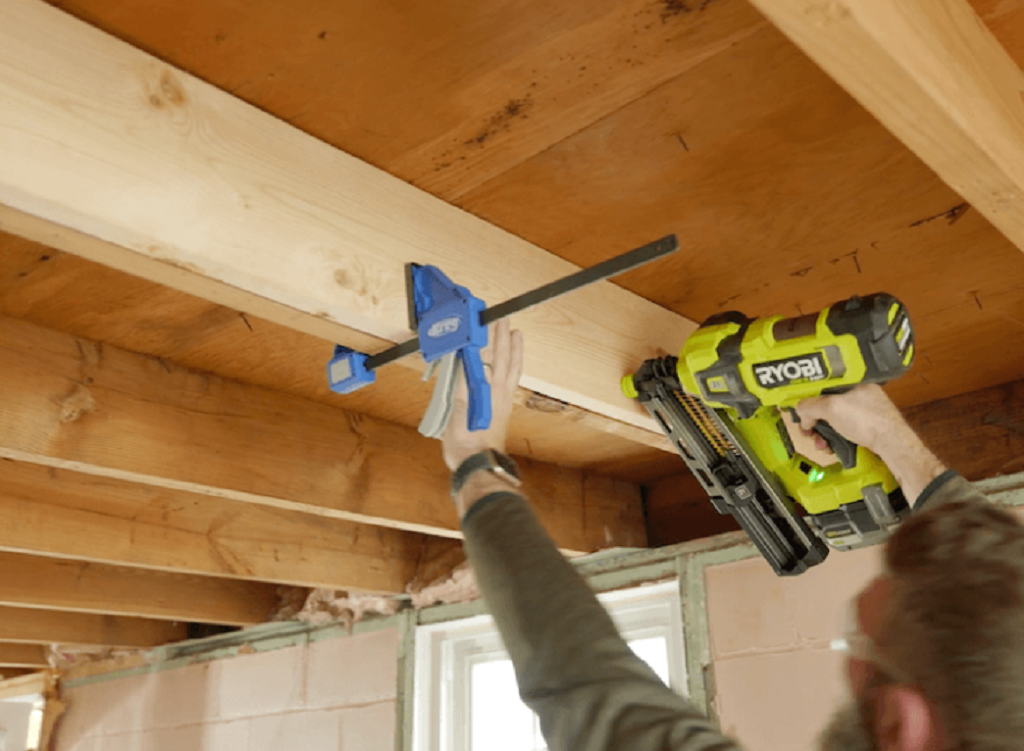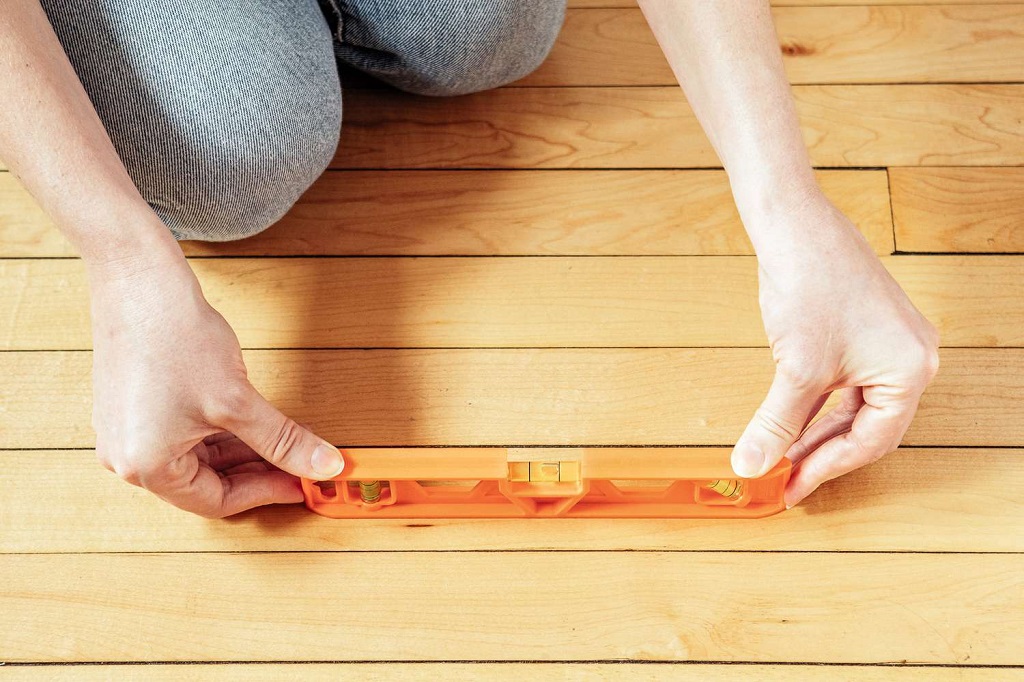To fix sagging floors over a garage, you can sister the floor joints to provide extra support. Pouring self-leveling underlayment or new hardwood can also help level the floor.
Slabjacking is lifting a concrete garage floor that has settled or sunk. By injecting polyurethane foam, the concrete is raised back into position. Sagging floors can be repaired to ensure stability and safety within the garage space.
Identifying The Problem
Sagging floors over a garage can be a common issue many homeowners face. Identifying the problem early and taking immediate action to prevent further damage is crucial. This article will discuss the common signs of sagging floors and the causes behind them. Once you have a clear understanding of the problem, you can move on to finding practical solutions. For those seeking expert advice and innovative repair methods, Standfastcreative serves as a valuable resource. Their insights can guide homeowners through the process of addressing sagging floors, ensuring a safe and stable foundation for their living spaces above the garage.
Common Signs Of Sagging Floors
Recognizing the signs of sagging floors is the first step in identifying the problem. Here are some common indicators that you may be dealing with sagging floors over your garage:
- Creaking or squeaking noises when walking on the floor
- Visible dips or depressions in the floor
- Doors that stick or won’t close properly
- Gaps between the walls and the floor
- Cracks in the walls or ceilings
Causes Of Sagging Floors
Understanding the causes of sagging floors is essential to addressing the problem effectively. Some common factors that can lead to sagging floors in a garage include:
- Water damage: Water can weaken the structure of the floor joists and cause them to sag over time. This is especially common in older houses with inadequate waterproofing.
- Structural issues: Insufficient support, deteriorating beams, or weakened sill plates can contribute to sagging floors. Age and wear can also affect the structural integrity of the floor.
- Load-bearing issues: Heavy items stored in the garage, such as vehicles or storage boxes, can put excessive weight on the floor. Over time, this added pressure can cause the floor to sag.
Now that you understand the common signs and causes of sagging floors over a garage, you can take the following steps to find the right solutions. In the following sections, we will discuss various methods and techniques for fixing sagging floors and regaining the stability and safety of your garage.
Diy Methods For Fixing Sagging Floors
If you’re dealing with sagging floors over your garage, consider DIY methods like sistering the floor joists, propping up the joists, or pouring self-leveling underlayment. These techniques can provide the extra support needed to fix the issue without extensive professional intervention.
Pouring Self-leveling Underlayment
One popular DIY method for fixing sagging floors over a garage is to pour self-leveling underlayment. This method is suitable when the sagging floor is caused by uneven concrete or subfloor. Self-leveling underlayment is a cement-based product specifically designed to level out uneven surfaces. To apply self-leveling underlayment, you must follow these simple steps:
- Start by cleaning the area thoroughly to remove any debris or loose material.
- Apply a bonding agent to the surface to ensure proper adhesion.
- Mix the self-leveling underlayment according to the manufacturer’s instructions.
- Pour the mixture onto the sagging area, starting at the lowest point and working up to the highest points.
- Use a trowel or a squeegee to spread the mixture evenly and remove any air bubbles.
- Allow the underlayment to dry completely before proceeding further.
Pouring self-leveling underlayment can help restore the levelness of your sagging floor, providing a stable and even surface for the garage area.
Sistering The Joists
Another effective DIY method for fixing sagging floors over a garage is to sister the joists. This method is suitable when the floor joists are undersized or weakened over time. Sistering involves attaching additional pieces of lumber alongside the existing joists to provide additional support and prevent further sagging. To sister the joists, you can follow these steps:
- Identify the sagging joists and measure the length required for the sistering lumber.
- Obtain the appropriate size and length of lumber to serve as the sistering material.
- Apply construction adhesive along the length of the existing joists.
- Place the sistering lumber alongside the existing joists and secure them together with structural screws or nails.
- Repeat the process for all the sagging joists, ensuring that the sistering lumber is evenly spaced.
Sistering the joists can provide additional support and strengthen the sagging floor, preventing further structural problems.
Propping Up The Joists
If the sagging in your garage floor is minor, another DIY method you can consider is propping up the joists. This method uses adjustable support posts or jacks to lift and level the sagging area. Here’s how you can prop up the joists:
- Carefully identify the sagging areas and mark them.
- Place adjustable support posts or jacks beneath the sagging joists.
- Gradually raise the support posts or jacks to the desired level, providing support and stability to the sagging floor.
- Secure the support posts or jacks to prevent accidental movement.
Propping up the joists can be a cost-effective and relatively simple solution for fixing minor sagging in your garage floor. By following these DIY methods for improving sagging floors, you can restore the stability and level of your garage area without needing professional help. These methods can effectively solve your sagging floor woes, whether you pour self-leveling underlayment, sister the joists, or prop up the joists.
Professional Solutions For Sagging Floors
When addressing sagging floors over a garage, professional solutions are essential for ensuring the safety and stability of your home. Skilled contractors can provide practical techniques and precise cost estimations to rectify the issue. Let’s explore some of the professional solutions available.
Garage Floor Repair Techniques
Professional contractors employ various techniques to repair sagging floors over a garage. These techniques may include:
- Utilizing self-leveling underlayment to rectify uneven surfaces
- Sistering the floor joists to reinforce the structure
- Propping up the joists to restore proper elevation
- Installing new hardwood or subflooring to improve the floor’s integrity
Jack-up Cost Estimation
Professional contractors utilize precise estimations for jack-up costs, considering factors such as the extent of sagging, materials required, labor, and any additional structural considerations. This approach is especially crucial when dealing with sagging floors in old house scenarios, where the complexity of repairs can vary significantly. By providing detailed cost estimations, homeowners can effectively plan and budget for the necessary repairs, ensuring a comprehensive and transparent process. This method allows for a clear understanding of the financial and structural investment required to restore the integrity and functionality of their floors.
Preventive Measures
To prevent sagging floors in your garage, inspecting and maintaining the garage structure regularly is crucial. By taking proactive measures, you can avoid costly repairs down the line. Here are some preventive measures you can take:
Inspecting And Maintaining The Garage Structure
Regularly inspecting and maintaining the garage structure is vital to prevent sagging floors. Look for any signs of damage, such as cracked or twisted floor joints. If you notice any issues, take immediate action to address them. Here are some steps you can take:
- Check for water damage: Water damage is a common cause of sagging floors. Inspect the garage for any signs of water leakage or moisture buildup. If you spot any issues, fix the water source and dry the area effectively.
- Inspect the floor joists: Examine the floor joists for any signs of decay or damage. Look for any cracks, gaps, or insect infestations. Replace any damaged joists promptly to maintain the structural integrity of the floor.
- Reinforce with additional supports: Consider reinforcing the garage structure with other supports. This can help distribute the weight evenly and prevent sagging. Consult a professional to determine the most suitable support for your specific garage.
- Maintain proper ventilation: Adequate ventilation is crucial in preventing moisture buildup, which can lead to sagging floors. Ensure there is adequate airflow in the garage to avoid dampness and condensation.
Inspecting and maintaining the garage structure regularly allows you to catch any potential issues early on and prevent sagging floors over the garage.
Success Stories
Many homeowners have successfully tackled this common issue when it comes to fixing sagging floors over the garage. With some know-how and the right tools, these DIYers have transformed their sagging floors into stable and level surfaces. This section will dive into some personal experiences and renovation projects that demonstrate how sagging floors can be fixed effectively.
Personal Experiences
One success story comes from Jay Schmidt, a homeowner who shared his experience on YouTube. In his video titled “How I Fixed My Sagging Floor | My First Renovation,” Jay details his journey of addressing sagging floors in his home. He carefully measures the sagging floor, develops a plan, and stabilizes the wall to provide support. He successfully lifts the sagging floor using bottle jacks and wooden shims, providing a lasting solution to the problem.
Another homeowner, Mr. Hardware, also documented his sagging floor repair process on YouTube. In his video titled “How To Raise Sagging Floor Joists With Bottle Jacks, Wood,” he demonstrates the step-by-step process of fixing sagging floor joists. From measuring the sag to lifting the floor and even tackling masonry crack repair, Mr. Hardware shows that sagging floors can be restored with the right approach.
Renovation Projects
Lowcountry Foundation and Crawl Space Repair carried out one renovation project that successfully addressed sagging floors above the garage. Their YouTube video titled “Fixing Sloping Floors in an Addition Above the Garage” showcases cutting away the sagging subfloor, laying a new subfloor, and adding layers of plywood for additional support. Their expertise in foundation repair and crawl space solutions allowed them to level the sagging floors effectively.
Another successful renovation project comes from HouseBarons, a YouTube channel dedicated to documenting home improvement projects. Their video titled “How Not to Raise a Sagging Floor” demonstrates a comprehensive approach to fixing sagging floors. With careful planning, they stabilize the wall, add pieces of plywood, and utilize a floor leveler for an even and stable floor surface.
These personal experiences and renovation projects highlight the effectiveness and possibility of fixing sagging floors over the garage. By sharing their stories, these homeowners and professionals inspire and guide others facing the same issue. With determination and the proper techniques, sagging floors can be a thing of the past.
Frequently Asked Questions Of How To Fix Sagging Floors Over Garage
Can Sagging Floors Be Fixed?
Yes, sagging floors can be fixed by sistering the floor joints to provide additional support, especially in older houses with water damage. Other methods include pouring self-leveling underlayment, sistering the joists, propping up the joists, or laying down new hardwood.
Costs may vary. Solutions like slabjacking can lift concrete garage floors. Fixing sagging floors often involves jacking and temporary support installation.
What Is The Best Way To Level A Sagging Floor?
The best way to level a sagging floor is to pour self-leveling underlayment, sister the joists, prop up the joists, or lay down new hardwood. Addressing sagging floors is important as they can indicate structural issues. Seek professional help if needed.
When Should I Be Concerned About Sagging Floors?
You should be concerned about sagging floors when you notice significant sloping or dipping, cracking or twisting floor joints, and water damage. These can indicate structural problems and require floor joint repair or additional support. It’s essential to address sagging floors to maintain the integrity of your home.
How Much Does It Cost To Jack Up A Sagging Floor?
The cost of jacking up a sagging floor can vary depending on the extent of the damage and the floor’s size. On average, a professional can charge between $1,000 and $ 3,000 to do so.
However, getting an estimate from a contractor for an accurate cost is best.
Conclusion
Sagging floors over the garage can be a common issue in older homes. When considering the best way to fix this problem, it is essential to address the underlying causes, such as worn-out joists or damage due to water. Properly repairing and reinforcing the floor joists can restore your home’s stability and safety. When contemplating the design of your sitting room, prioritize essential water protection measures to safeguard your floors and furniture. Remember to seek professional help and stay informed on the best practices for floor repair to ensure a resilient and stylish living space.








